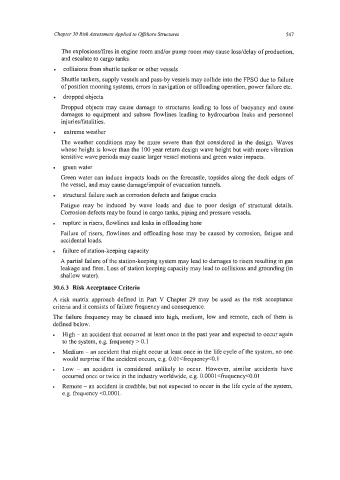Page 571 - Marine Structural Design
P. 571
Chapter 30 Risk Assessment Applied to Ofshore Structures 547
The explosions/fires in engine room and/or pump room may cause loss/delay of production,
and escalate to cargo tanks.
collisions from shuttle tanker or other vessels
Shuttle tankers, supply vessels and pass-by vessels may collide into the FPSO due to failure
of position mooring systems, errors in navigation or offloading operation, power failure etc.
dropped objects
Dropped objects may cause damage to structures leading to loss of buoyancy and cause
damages to equipment and subsea flowlines leading to hydrocarbon leaks and personnel
injuriedfatalities.
extreme weather
The weather conditions may be more severe than that considered in the design. Waves
whose height is lower than the 100 year return design wave height but with more vibration
sensitive wave periods may cause larger vessel motions and green water impacts.
green water
Green water can induce impacts loads on the forecastle, topsides along the deck edges of
the vessel, and may cause damagelimpair of evacuation tunnels.
structural failure such as corrosion defects and fatigue cracks
Fatigue may be induced by wave loads and due to poor design of structural details.
Corrosion defects may be found in cargo tanks, piping and pressure vessels.
rupture in risers, flowlines and leaks in oftloading hose
Failure of risers, flowlines and offloading hose may be caused by corrosion, fatigue and
accidental loads.
failure of station-keeping capacity
A partial failure of the station-keeping system may lead to damages to risers resulting in gas
leakage and fires. Loss of station keeping capacity may lead to collisions and grounding (in
shallow water).
30.6.3 Risk Acceptance Criteria
A risk matrix approach defined in Part V Chapter 29 may be used as the risk acceptance
criteria and it consists of failure frequency and consequence.
The failure frequency may be classed into high, medium, low and remote, each of them is
defined below.
High - an accident that occurred at least once in the past year and expected to occur again
to the system, e.g. frequency > 0.1
Medium - an accident that might occur at least once in the life cycle of the system, no one
would surprise if the accident occurs, e.g. O.Ol<fiequency<O.l
Low - an accident is considered unlikely to occur. However, similar accidents have
occurred once or twice in the industry worldwide, e.g. O.OOOl<frequency<0.01
Remote - an accident is credible, but not expected to occur in the life cycle of the system,
e.g. frequency <0.0001.

